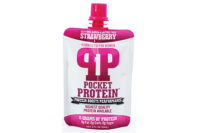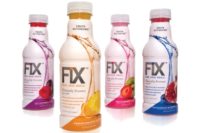The classic fairy tale “Beauty and the Beast” teaches people that beauty comes from within. In the beverage industry, this takes on a more literal meaning. Consumers both young and old are buying into the idea that the products they consume can have a direct correlation to their outward appearances, says Dan Murray, vice president of business development for Xsto Solutions, Morristown, N.J.
Although more popular in the pharmaceutical and cosmetic industries, beauty and anti-aging claims have made their way into the beverage market during the last 10 years, says Nithya Hariharan, market research analyst for DSM, Parsippany, N.J., citing data from Chicago-based Mintel. In 2008, Activate Drinks, a brand of The Rising Beverage Co. LLC, Newport Beach, Calif., launched its Exotic Berry variety with a functional claim for beauty as part of its line of nutrient-enhanced bottled waters. The beverage provides overall health and skin cell support through a proprietary antioxidant blend that includes tea, polyphenols, epigallocatechin gallate (EGCG) and acai extract, says Jesse Merrill, vice president of Activate Drinks. This variety has been particularly popular among active-lifestyle female consumers because of its functionality and flavor, and it is the brand’s No. 2-selling variety, he adds. More recently, approximately 12 new products with beauty and anti-aging claims have launched in the United States since Jan. 1, 2012, according to the Mintel Global New Products Database. These include relaxation drinks, teas, a hard cider, powdered drink mixes, kombucha and an anti-aging collagen protein shake.
Like Activate’s product, beauty and anti-aging drinks are typically targeted toward women with active lifestyles who are looking for convenient and healthy alternatives to snacking, DSM’s Hariharan says. The beverage industry offers a convenient, on-the-go, yet tasty way to consume a dose of the vitamins, carotenoids, minerals, nutritional lipids and other ingredients for healthy skin and other beauty benefits without requiring them to go through a time-consuming cosmetic process, she says. Plus, beverages usually can offer greater quantities of beneficial nutrients than supplement capsules, contributing to quicker results, adds Danielle Black, product manager for The Scoular Co., Minneapolis.
When creating a beverage with functional claims for beauty, beverage-makers should include a blend of ingredients that have been scientifically shown to support this benefit, says Deshanie Rai, senior scientific leader at DSM. For example, vitamins A, B5, B6, C and E; zinc; selenium; copper; carotenoids; omega-3 fatty acids; and isoflavones have been shown to support skin health by scavenging free radicals produced as a result of sun exposure, increasing collagen and elastin synthesis, or supporting skin’s barrier function, she says. DSM, in conjunction with Kemin Health LC, Des Moines, Iowa, offers FloraGlo lutein, a product that has been clinically shown to increase skin hydration and elasticity while decreasing skin lipid peroxidation, the company says. FloraGlo is featured in many of DSM’s beauty formulations that target specific areas of beauty concern, it adds.
Drinking away the wrinkles
As the baby boomer population ages, the market is seeing an increasing interest in products with anti-aging properties, Xsto’s Murray says. According to Kline & Co., a market research firm based in Parsippany, N.J., anti-aging is the single largest product type in the global personal care market, and it has been outpacing total beauty growth since 2010. Fortitech Inc., Schenectady, N.Y., also sees continued growth for this market in the future.
“The increased number of older people in the world and their concerns for rejuvenation and the maintenance of a more youthful appearance will provide a strong demographic foundation for the future growth of sales,” Fortitech said in its 2009 technical paper, “Age-defying Nutrients.”
When it comes to ingredients with anti-aging effects, antioxidants are most commonly associated with this particular beauty benefit because of oxidation’s role in skin aging, says Diane Hnat, senior technical marketing manager at DSM. Resveratrol, an antioxidant found in peanuts, mulberries, grapes, Japanese knotweed and red wine, has been increasing in popularity since 2000 and has become increasingly popular in non-supplement applications in the last few years, says Innova Market Insights, Duiven, the Netherlands. Studies have found that resveratrol can help prevent the free radical damage that can lead to the premature aging of cells, the market research firm says.
Ethical Naturals Inc. (ENI), San Anselmo, Calif., offers Super-Soluble Resveratrol – 10 percent, a form of resveratrol specifically designed for beverage applications. “Due to its characteristic chemical structure, resveratrol is not soluble in water, and this is an obstacle to its use in beverage applications,” the company says. Using a nanometer lipid carrier technique to create the super-soluble form, ENI has developed a form suitable for beverage applications, it says. The ingredient also offers a smooth texture and hides the natural odor and taste of resveratrol so that the sensory profile of the beverage will not be affected, it adds.
Although non-supplement products containing resveratrol currently are relatively limited, Innova Market Insights notes that there are high levels of interest in the ingredient in the United States and expects that it will grow in popularity in the coming years.
Another anti-aging ingredient with the potential to move into the U.S. beverage market is The Scoular Co.’s Naticol. This fish collagen peptide is used in anti-aging formulas because it is a Type 1 collagen, which makes up more than 70 percent of the body’s collagen protein and is naturally found in skin, hair, nails, joints, cartilage, veins and other parts of the body, The Scoular Co.’s Black says. In clinical studies testing the anti-aging effects of Naticol, researchers found that women in their 50s and 60s who ingested 10 grams of Naticol mixed in 6.8 ounces of liquid each day showed a more than 20 percent increase in skin elasticity and hydration and a 9 percent decrease in wrinkles, she says. Beyond measurable beauty benefits, consumers also reported that, when they looked in the mirror, they perceived that their skin was becoming healthier and looking more youthful and rejuvenated, she adds.
The powdered protein has not yet been used in beverages in the United States, but it is popular in Japanese markets, and it has a burgeoning market in Europe, Black says. “I think there’s a huge market space of women looking to improve their skin tones that is wide open for this application,” she says. “I think that the applications are pretty limitless … Functionally, it’s easy to dissolve and it becomes clear.” Suitable for powdered dry mixes or ready-to-drink products, the ingredient shows potential in protein beverages or juices, she says.
“I think people are just more open to the idea [of] having a drink [that] packs a health punch — something more than just a soda or coffee; people want soy milk plus vitamins, juice plus probiotics,” Black says. “I think now we’re seeing Generation Y, who’s open to taking dietary supplements not just in a pill or tablet form but also in the form of a beverage … and that functional food idea is catching on big time.” BI
Aging gracefully on the inside
By Jennifer Haderspeck
Although aging is part of life, Hilmar Ingredients, Hilmar, Calif., offers an ingredient that can help consumers age gracefully. Hilmar 9420 is a highly functional, 90 percent whey protein isolate that is designed for fortification in neutral and low pH beverages, says Grace Harris, director of applications and new business at Hilmar. It delivers all amino acids needed for good human health while mixing clear into the liquid and reducing astringency in high-acid applications, she says.
As seniors tend to consume smaller volumes and have less efficient metabolisms, it is important that they consume beverages with high nutritional quality, particularly those with a complete protein like whey, to ensure that they meet energy and nutrient requirements, says Gwen Bargetzi, director of marketing at Hilmar. Research suggests that the essential amino acids found in whey protein can stimulate muscle synthesis and combat sarcopenia, a loss in skeletal muscle mass commonly associated with aging, the company says. This helps aging consumers to retain the muscle needed to remain active later in life, Bargetzi says.
“With the advent of new medicines and medical procedures, we are not only living longer, but living healthier, and we expect our old age to be healthier as well,” Bargetzi says. “The task of feeding us for health has fallen to formulators who must hit the winning product trifecta: nutritional, good tasting and appealing.”
To appeal to the weak taste buds of older consumers, Hilmar recommends mixing Hilmar 9420 into a highly flavored beverage. As an ingredient with a bland flavor profile, Hilmar 9420 does not interfere with other beverage flavors, Bargetzi says. The company also recommends mixing Hilmar 9420 into iced teas, orange juices and other familiar beverages popular among older consumers, as the ingredient will not impact the beverage’s color or viscosity, she adds.







